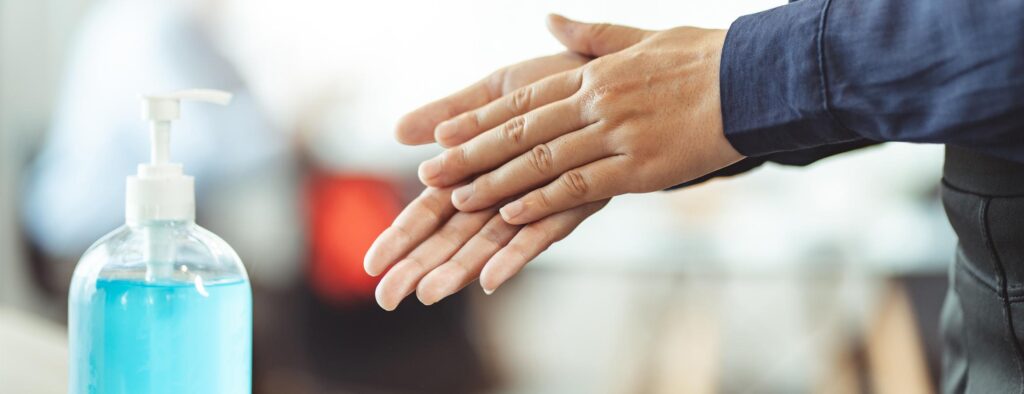
As vaccines start to roll out across the country, people are beginning to imagine what life could once again be like without the constant fear of catching the virus. As businesses nationwide are gearing up for returning to normalcy, we must remember that we are not out of the woods yet. There is still a fight to be fought on the front lines of your work environment.
Businesses wanting to reopen this year need to make a plan to continue to prevent the spread of the virus. Until everyone is vaccinated and we as a society have achieved herd immunity, it is still crucial to have cleaning and safety measures to protect your employees’ and customers’ health and safety. This article discusses how to develop, implement, maintain, and eventually revise your coronavirus defense plan as time goes on.
How Coronavirus Spreads
Unless you have been living under a rock for the last year, you are probably aware of some of the ways someone can catch COVID-19. In case you aren’t aware, here is a brief breakdown of how the virus spreads so you understand what you are up against as a business owner. The virus is spread mainly person-to-person, including:
● Between people who are in close contact with one another (within about 6 feet) for a duration longer than 15 minutes.
● Through respiratory droplets produced when an infected person coughs or sneezes. These droplets can land in the eyes, mouths or noses of nearby or possibly inhaled into the lungs.
It may be possible that a person can get COVID-19 by touching a surface or object that has SARS-CoV-2 on it and then touching their mouth, nose, or possibly their eyes, but this is not the primary way the virus spreads.
People are likely most contagious when they are most symptomatic (i.e., experiencing fever, cough, and shortness of breath). Some spread might be possible before people show symptoms; there have been reports of this type of asymptomatic transmission with this new coronavirus, but this is also not thought to be the primary way the virus spreads.
Knowing what you’re up against is half the battle. Now let’s discuss how to combat the spread of the coronavirus.
Develop and Implement a Cleaning and Disinfecting Plan
For America to reopen again, businesses will need to implement a multi-faceted strategy to fight the virus. This approach includes increased testing of employees for the virus, social distancing among customers and employees, self-isolation if possible, and keeping track of how someone infected might have infected other people.
This plan is part of the larger United States Government plan and focuses on cleaning and disinfecting public spaces, workplaces, businesses, schools. This strategy can also be useful if implemented at home.
When developing your plan, the first step is to evaluate your environment. You’ll need to assess which areas require the most attention in terms of sanitation. Surfaces such as countertops, sinks, door handles, buttons on the microwave, communal computers, handles on the refrigerator, the list goes on. Once you’ve identified the highest risk areas, you can implement a regular cleaning schedule to maintain those areas regularly.
In terms of sanitizing the office, the EPA has released a list of chemicals proven to kill the COVID-19 virus. Consider stocking up on products containing the following chemicals:
● Hydrogen peroxide
● Sodium hypochlorite
● Quaternary ammonium
● Thymol
● Isopropyl alcohol
● Hypochlorous acid
If you cannot obtain any of these chemicals, the next best solution is good old-fashioned soap and water. Soap breaks down the cell walls of the virus and kills it within seconds. Because of this, begin all sanitizing processing with a soap and water bath followed by an EPA-approved disinfectant.
Soft and porous materials are generally not as easy to disinfect as hard and non-porous surfaces. Those not frequently touched should only be cleaned or laundered, following the item’s label’s directions, using the warmest appropriate water setting.
On top of regular sanitation, we must be steadfast in our current safety practices. Even if it sounds like a broken record by this point, we must continue:
● social distancing (specifically, staying 6 feet away from others when you must go into a shared space)
● frequently washing hands or use alcohol-based (at least 60% alcohol) hand sanitizer when soap and water are not available
● wearing masks, especially N95s
● avoiding touching eyes, nose, and mouth
● staying home when sick
● cleaning and disinfecting frequently touched objects and surfaces
When in Doubt, Follow Current OSHA Standards
Existing OSHA standards may apply to protecting workers from exposure to and infection with SARS-CoV-2. While there is no specific OSHA standard covering SARS-CoV-2 disclosure, some OSHA requirements may apply to preventing occupational exposure to SARS-CoV-2. Among the most relevant are:
● OSHA’s Personal Protective Equipment (PPE) standards (in general industry, 29 CFR 1910 Subpart I) require using gloves, eye and face protection, and respiratory protection.
● When respirators are necessary to protect workers or employers require respirator use, employers must implement a comprehensive respiratory protection program.
● The General Duty Clause, Section 5(a)(1) of the Occupational Safety and Health (OSHA) Act of 1970, 29 USC 654(a)(1), which requires employers to furnish to each worker “employment and a place of employment, which are free from recognized hazards that are causing or are likely to cause death or serious physical harm.”
OSHA’s Blood borne Pathogens standard (29 CFR 1910.1030) applies to occupational exposure to human blood and other potentially infectious materials that typically do not include respiratory secretions that may transmit SARS-CoV-2.
However, the standard provisions including commercial air filtration offer a framework that may help control some sources of the virus including exposures to body fluids (e.g., respiratory secretions) not covered by the standard.
If you have questions about what commercial air filters you need, call Advanced Filtration Concepts today

Advanced Filtration Concepts is a
Certified Veteran-Owned Small Business.
